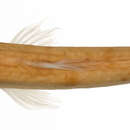pms
nòm ant ël fil


Skelton (1989) redefined the genus Paramphilius emphasizing a highly modified head structure as the most obvious derived feature separating these fishes from other amphiliids. In Paramphilius the tiny eyes are displaced anteriorly on the head by the extreme development of the adductor mandibulae muscles which extend behind the orbits to insert onto the dorsal aspect of the neurocranium. In larger males of Paramphilus the adductor mandibulae are enlarged (hypertrophied) and cause the post-orbit region to bulge noticeably. Paramphilius are soft bodied and cylindrical in shape, the fins are short, rounded and relatively weak compared to other amphiliids. The predorsal length is extended so that the dorsal fin is displaced relatively far back from the head and is positioned above the pelvic fins. A low number of gill rakers (<5 on leading arch) is characteristic. The genus was originally defined by Pellegrin (1907) on having a long, low adipose fin confluent with the dorsal fold of the caudal fin. This character is however unreliable at the generic level as there are both Amphilius species with such a condition, and secondly that it is variable within a species (see Skelton, 1984). Within Paramphilius the character appears to be consistent within the species, but it is not within the genus (Skelton, 1989). The largest species in the genus is Paramphilius baudoni (see below) and only this species has a short notched adipose fin.
This review indicates that a single somewhat variable species occurs in West Central Africa and is represented in collections mostly by a species formerly known as Amphilius baudoni but also by the species Paramphilius goodi . A detailed comparison of the type specimens of A. baudoni with the holotype and one paratype of P.goodi (Table 5) indicates the close physical similarity of the specimens on which the decision to synonymize the nominal species rests. The main difference between the types is in the Principal Caudal fin rays of P. goodi (7+8 vs. 8+9 of A.baudoni ). Although this character might indicate a taxonomic difference with only the type specimens of P. goodi available for examination, there is insufficient reason to avoid the synonymy at present.
There are three Paramphilius species in the Upper Guinean region of West Africa, Paramphilius firestonei Schultz, 1941 , Paramphilius teugelsi Skelton, 1989 , and Paramphilius trichomycteroides Pellegrin, 1907 (Skelton et al., 2003). These species are all smaller sized species and differ in body proportions, especially depth, fin ray counts and the form of the adipose fin (short and notched posteriorly in A. baudoni vs.long, low and confluent with dorsal caudal fin fold in West African Paramphilius species).